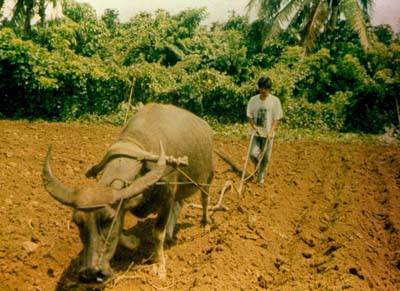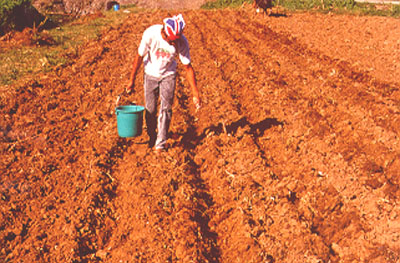Soil fertility refers simply to the ability of a soil to support plant growth.
It is a product of
- the soilís physical structure (which determines aeration,
water-holding capacity and root penetration) and
- its chemical fertility (its ability to supply essential nutrients to the
plant).
Both physical and chemical characteristics of the soil tend to deteriorate
due to cultivation of crops and removal of harvested product. Methods available
to maintain soil fertility include:
|
Soil Structure |
Soil chemical fertility |
∑ fallowing under natural vegetation
∑ rotation with pasture
∑ incorporation of organic matter, especially
slow-degrading (eg. straw)
∑ soil ameliorants: eg. gypsum, lime
∑ minimum tillage and controlled traffic techniques
∑ preventing surface runoff and erosion
(eg. contour ridges or hedgerows, applying surface mulches)
|
∑ fallowing
with natural or planted species, especially legumes
∑ growth and incorporation of green manure crops
∑ incorporation
of organic matter, especially fast-degrading (eg. manure and composts)
∑ chemical fertilizers
∑ retaining crop and weed debris in the field as mulch.
|
Both physical and chemical characteristics of the soil affect, and are affected
by, the soil biology. A healthy soil has a balanced population of
bacteria, fungi and tiny animals, which have direct and indirect effects on
plant health. While soil biology is often overlooked, many problems
associated with soil deterioration and soil-borne diseases are associated with
an imbalance in soil organisms. Preserving soil structure and organic
matter levels is the best way to ensure a healthy soil ecosystem.
Contributed
by:
Jane O'Sullivan
|
Further
topics on Soil Management:
Soil
structure
Soil
organic matter
Plant
nutrients
Fertilisation
Causes
of nutritional disorders
Diagnosing
nutritional
disorders
Correcting
nutritional
disorders
Other topics on Crop Management: Land
preparation
Planting
material preparation
Planting
Water
management
Vine
lifting
Integrated
pest management
Harvesting
Postharvest
practices

A
loose-textured soil is good for sweetpotato production (F. Villamayor).

Fertiliser
application before planting in the Philippines (F. Villamayor). |

